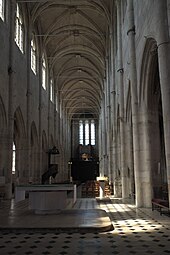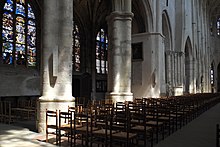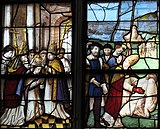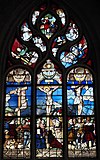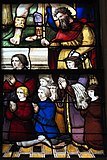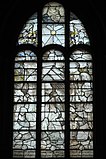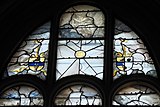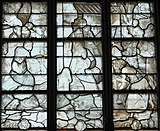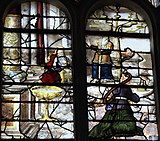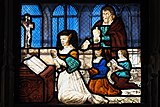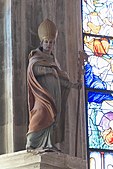St-Pierre (Montfort-l'Amaury)
The Catholic parish church of Saint-Pierre in Montfort-l'Amaury , a parish in the Yvelines department in the French region of Île-de-France , dates back to a Romanesque church from the 11th century. The current church was essentially built in the 16th century. In 1840 the church consecrated to the Apostle Peter was one of the first buildings to be included in the list of architectural monuments in France as a monument historique due to its numerous stained glass windows from the 16th century .
history
Only the north wall of the former bell tower remains of the Romanesque church. Around 1491, Anne de Bretagne , the Countess of Monfort , who had become Queen of France through her marriage to Charles VIII , had a new church built in the Gothic style . With Anne's death in 1514, construction work was interrupted. It was not until almost 20 years later under Count André de Foix that the work was continued and the five-bay choir with ambulatory was completed. In addition, a further yoke with the south portal in the Renaissance style was added along the south side of the Romanesque bell tower. By the beginning of the 17th century, the nave was extended to the west by another five yokes, which is reminiscent of the year 1613 carved on the west portal. The construction work was then interrupted for over 200 years. The old bell tower still stood between the choir and the nave . It was not until 1848 that the new bell tower was built over the west facade and the nave was raised to the height of the choir. In imitation of the stone ribbed vault in the choir, it was covered with a false vault made of plaster and the aisles were provided with - albeit less elaborate - hangings based on the ambulatory . The new tower received the top and the bells of the old Romanesque tower, which was then demolished except for the north wall built into the nave with its two arched twin windows .
architecture
Exterior construction
Under the tower, a wide arch, framed by fluted pilasters decorated with Corinthian capitals , opens up to a vestibule with the west portal. The outer walls of the nave and the choir are divided by large tracery windows and massive buttresses, which are crowned by vases and decorated with numerous gargoyles. Still in the Gothic style built choir and its semicircular apse are buttresses reinforced that are collected by the buttresses that extend here up to the clerestory windows. On the south side of the nave is the Renaissance portal with two doors above which small canopies and ornamental gables with the busts of André de Foix and his wife, Catherine du Bouchet, are attached.
inner space
The church has a length of 65 meters and a width between 20 and 21 meters. The height of the choir and the main nave is 17.40 meters, the side aisles and the ambulatory are half as high. The dreischiffige nave is divided into six yokes divided, the five-nave Choir with ambulatory ends with a semicircular apse.
Leaded glass window
Leaded glass window from the 16th century
37 windows from the 16th century have been preserved in the church. Five windows are provided with dates, the oldest is 1543, the other dates are 1544, 1572, 1574 and 1578. The windows have no signatures and the glass painters are not known. Engravings by Albrecht Dürer , Lucas van Leyden and Marcantonio Raimondi were probably used as models . The detailed scenes in the background, often executed in grisaille technique, are remarkable . The windows were donated by notables from the city and the surrounding area, members of brotherhoods and ordinary citizens, whose names were probably recorded in inscriptions that have not survived. Some donors can be identified by their coat of arms. In the years from 1838 to 1855, the first extensive renovation of the windows was carried out, mainly by the glass painting workshop of Laurent-Charles Maréchal and Louis-Napoléon Gugnon in Metz.
- Window 1
The Manna rain is depicted on the two lancets of the left choir window . In the tympanum you see Moses knocking water out of the rock. The window is dated to the middle of the 16th century.
- Window 2
The right choir window depicts the sacrifice of Isaac . In the tympanum, God the Father is depicted with the papal crown , surrounded by banners and angels holding the instruments of suffering in their hands. The window was created in the years 1540-1550.
- Window 3
The window depicting St. Eustachius dates from the mid-16th century. It has been heavily restored and the panes have been reassembled from different windows. Under Eustachius one of his sons is shown in the mouth of a wolf. On the right lancet you can see a deacon with the Lamb of God underneath .
- Window 5
The Pentecost scene with the donors of the window is shown on the two lancets . The golden tongues over Mary and the apostles symbolize the sending of the Holy Spirit . The window dates from the middle of the 16th century, the representation of the Trinity in the tympanum has been renewed.
- Window 6
Emperor Charlemagne and the French King Louis the Saint are depicted on the two lancets , in the tympanum the crucifixion of Christ with Mary Magdalene at the feet of the cross, including Mary and John. The heavily restored window was created in the second quarter of the 16th century.
- Window 7
The window was executed around 1540-1550. On the two lancets the death of Mary is depicted in the circle of the apostles and in the tympanum the coronation of Mary by the Trinity is depicted. The scene is embedded in antique architecture against the background of a landscape with ruins. On the lower right edge of the picture, the founder kneels in front of his patron saint, St. Claudius von Condat , on the left side you can see his wife with two daughters and their patron, St. Rochus of Montpellier .
- Window 8
The window dates from the second quarter of the 16th century. Five episodes from the legend of St. Eligius are shown on the two lancets and in the tympanum . He forges two golden saddles, works miracles and heals the sick, and is ordained bishop of Noyon .
- Window 9
The window from the middle of the 16th century shows the conversion of the Apostle Paul on the way to Damascus. The risen Christ appears in the tympanum, on the lower left pane a saint kneels before a Roman soldier, on the right Paul is beheaded with the sword.
- Window 10
On the two lancets you can see the two thieves on the cross and in the middle the cross of Christ, including the lamentation of the body of Jesus. In the tympanum, the archangel Michael is depicted, who defeats the dragon. The window is dated to the middle of the 16th century.
- Window 11
The window dates from the middle of the 16th century. The three lancets show Christ on the cross in the middle and the two thieves to the side. Maria Magdalena embraces the foot of the cross, in the tympanum she meets Jesus after his resurrection as a gardener ( Noli me tangere ), surrounded by angels with the tools of suffering. The figures in the lower right scene, who turn away from the cross, on the side of the unrepentant thief, are also interpreted as representatives of the Reformation such as Martin Luther , Johannes Calvin and Zwingli , the middle figure, dressed in knight armor, as Emperor Charles V.
- Window 12
The time of creation of the window is dated between 1540 and 1550. The temptation of Jesus in the desert is depicted on the two lancets ; in the tympanum, Jesus is provided with food by an angel.
- Window 13
The window from the middle of the 16th century is divided into three lancets and was restored in 1724. It depicts scenes from the life of the apostle Peter, his capture and release from prison by an angel. In the two smaller panes in the tympanum, Peter seeks out Mary and the apostles after his liberation, on the other pane King Herod , who had Peter captured, is punished by an angel. At the bottom of the picture you can see the couple and their coat of arms.
- Window 14
In the middle of the three-lane window is the resurrection of Christ with the sleeping guards at the grave and in the tympanum his ascension to heaven in front of the apostles and his disciples. At the bottom of the picture you can see the donors, on the left a family with their patron saint, John the Baptist , in the middle a donor with a bishop at his side with his coat of arms, on the right a donor couple with the apostle Peter. The window dates from the middle of the 16th century.
- Window 15
The window shows Jesus and the sleeping disciples on the Mount of Olives in the tympanum. On the three lancets below you can see the betrayal by Judas on the right , the flagellation of Christ on the left and the scene of Ecce homo in the middle . The year 1544 can be read on the left lancet. At the lower edge of the picture, the donor couple dressed in expensive fur coats kneels with their coat of arms in the middle.
- Window 16
The three-lane window is marked with the year 1543. It depicts scenes from the life of Mary and the childhood of Jesus, above the Annunciation to Mary by the Archangel Gabriel , the Nativity and the Annunciation to the Shepherds, below the Adoration of the Magi , the circumcision of Jesus , the presentation in the temple and in Background the flight into Egypt . The representation of the Assumption of Mary in the tympanum has been renewed.
- Window 17
The window dates from the third quarter of the 16th century. On the three lancets the transfiguration of Jesus is shown in the upper part and the apostles John , James and Peter in the lower part . At the very top you can see God the Father with the globe, underneath a tape with the inscription: "HIC EST FILIUS MEUS DILECTUS" (this is my beloved son).
- Window 18
Various scenes from the life of St. Ivo Hélory are depicted on the three-lane window from the middle of the 16th century . A donor clad in precious fur is kneeling on the lower right pane.
- Window 20
On the window a crucifix appears in the antlers of a deer to Saint Hubertus on the hunt. The window from the mid-16th century was restored by Laurent-Charles Maréchal in 1722 and in the 19th century. The panes of the tympanum with scenes from the life of the saint have been renewed.
- Window 21
Only one pane of the window from the late 16th century remains, on which an angel appears over a landscape with two people. The meaning of the scene is not clear.
- Window 23
On the mid-16th century window are Saint Sebastian , Saint Roch of Montpellier and Abbot Godo of Oyes (Gond), co-founder of Saint-Wandrille Abbey in Normandy and founder of Saint Gond Abbey in Oyes in the Champagne depicted. In the tympanum you can see the three saints in a heraldic cartouche.
- Window 24
The three-lane window from the middle of the 16th century is executed in grisaille technique with silver solder and depicts the adoration of the Magi. On the upper pane of the tympanum you can see an angel and to the side two angels holding heraldic cartouches.
- Window 25
Scenes from the story of Joseph are depicted on the window . The window from the third quarter of the 16th century was restored in 1723 and later almost completely renewed. Only the panes in the tympanum, on which Joseph tells his brothers a dream, and the two scenes in which Joseph is thrown into a cistern by his brothers and his brothers show their father the blood-soaked skirt of Joseph, are still original.
Joseph and Potiphar's wife, Joseph and Pharaoh, Joseph hugs his brother Benjamin
- Window 26
The window is marked with the year 1572. In the upper part it shows Anna and Joachim , the parents of Mary, whose offering is rejected by the high priest. In the lower part, on the left, the Annunciation to Joachim by an angel and the meeting of Joachim and Anna at the Golden Gate, in the middle and on the right, scenes of the birth of Mary are shown.
- Window 27
On the three-lane window from the late 16th century, the Assumption of Mary is shown in the middle and the donor couple with their children below. In the tympanum, God the Father and angels float above the clouds.
- Window 28
The three lancet window with scenes from the life of Mary was also created in the late 16th century. In the upper part the passage of the Virgin Mary is shown, in the lower part her marriage to Joseph . The scene in the tympanum shows the Visitation of Mary .
- Window 29
The three-lane window from the late 16th or early 17th century is dedicated to the Works of Mercy . In the middle a woman is breastfeeding a child, on the left a beggar receives a gift, on the right a dead person is buried. In the center of the tympanum a coat of arms is depicted, on the left a visit to a prison, on the right a needy person receives food and clothing.
- Window 30
The window is divided into three lancets and marked with the year 1574. In the middle lancet Mary is shown with the baby Jesus, surrounded by her symbols and invocations , which are reproduced in the Latin language on the tapes. The scene above left shows Joseph asleep to whom an angel announces the birth of Jesus, in the scene below you can see the Holy Family. The upper right scene shows the return of the Holy Family to Jerusalem, the lower scene the twelve-year-old Jesus in the temple among the scribes. God the Father and angels are represented in the tympanum.
- Window 32
The window is marked with the year 1578 and shows the raising of Lazarus . In the tympanum, God the Father is represented surrounded by angels. On the lower edge of the picture you can see the donor family kneeling in front of a figure of Mary with their coat of arms.
- Upper choir window
The crucifixion scene is shown on the central upper choir window (window 100). On two windows (windows 101 and 102) you can see the apostles James and John as well as Peter and Andrew . A further Pentecost scene is shown on window 103. Windows 104, 105, 109 and 111 depict martyrs and scenes of torture. In window 113, panes depicting the temptation of Adam and Eve are preserved, which are made using the technique of grisaille with silver solder.
Window 105, Dionysius of Paris and Martyr
More windows
- Window 4
The window depicting the root of Jesse was created in Paris in 1840 by the glass painter Louis Alexandre Billard and donated by the Lambin family, shown below.
- Window 22
The round window with the representation of the rose miracle of St. Elisabeth of Thuringia was installed in 1881. It was made by an unknown glass painter in memory of Elisabeth-Virginie Cardon, as can be read in the inscription on the left.
Furnishing
- The colored carved figures of two bishops are works from the 17th century.
- Two holy water stoups on capitals are dated to the middle of the 11th and the first quarter of the 12th century.
literature
- Louis Grodecki, Françoise Perrot, Jean Taralon (eds.): Les vitraux de Paris, de la région parisienne, de la Picardie et du Nord-Pas-de-Calais . (= Corpus Vitrearum Medii Aevi ). Récensement des vitraux anciens de la France. Volume 1, Éditions du Center National de la Recherche Scientifique, Paris 1978, ISBN 2-222-02263-0 , pp. 132-135.
- Laurence de Finance, Marie-Huguette Hadrot: Les verrières de l'église paroissiale Saint-Pierre . Itinéraires du Patrimoine (No. 68), Inventaire général SPADEM, Paris 1994, ISBN 2-905913-14-2 .
Web links
- L'église Saint-Pierre Mairie de Montfort l'Amaury
- Saint-Pierre de Montfort-l'Amaury
- Église Saint-Pierre Saint-Paul patrimoine-religieux
Individual evidence
- ↑ Stained glass window in the Base Palissy of the French Ministry of Culture (French)
- ↑ Église Saint-Pierre in the Base Mérimée of the French Ministry of Culture (French)
- ^ Godo Bibliothèque nationale de France
- ↑ Two bishops in the Base Palissy of the French Ministry of Culture (French)
- ↑ Holy water font in the Base Palissy of the French Ministry of Culture (French)
Coordinates: 48 ° 46 ′ 36.1 ″ N , 1 ° 48 ′ 28.1 ″ E




